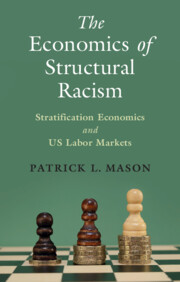Book contents
- The Economics of Structural Racism
- Cambridge Studies in Stratification Economics: Economics and Social Identity
- The Economics of Structural Racism
- Copyright page
- Dedication
- Contents
- Figures
- Tables
- Part I Foundations
- Part II African American Educational Progress and Transformations in Family Structure, 1965–Present
- Part III African American Income and Wealth, 1965–Present
- 7 Family Income Growth and Inequality
- 8 Family Wealth Inequality
- 9 Individual Wage and Employment Disparity
- 10 African American Cultural Diversity
- Part IV Structural Racism, 1965–Present
- Part V Restatement and Discussion
- References
- Index
8 - Family Wealth Inequality
Pensions, Homeownership, and Property Income
from Part III - African American Income and Wealth, 1965–Present
Published online by Cambridge University Press: 06 April 2023
- The Economics of Structural Racism
- Cambridge Studies in Stratification Economics: Economics and Social Identity
- The Economics of Structural Racism
- Copyright page
- Dedication
- Contents
- Figures
- Tables
- Part I Foundations
- Part II African American Educational Progress and Transformations in Family Structure, 1965–Present
- Part III African American Income and Wealth, 1965–Present
- 7 Family Income Growth and Inequality
- 8 Family Wealth Inequality
- 9 Individual Wage and Employment Disparity
- 10 African American Cultural Diversity
- Part IV Structural Racism, 1965–Present
- Part V Restatement and Discussion
- References
- Index
Summary
The mean African American family wealth is 6–8 percent of mean White family wealth. About 1 of every 3 African American families are bankrupt. Both numbers were unchanged during 1984–2017. The African American savings rate is at least as high as the White savings rate for families with the same level of earnings (income). Racial differences in inheritances and in vivo transfers explain the greatest portion of racial wealth disparity.
Keywords
- Type
- Chapter
- Information
- The Economics of Structural RacismStratification Economics and US Labor Markets, pp. 191 - 230Publisher: Cambridge University PressPrint publication year: 2023

